Thou shall not steal our trains…
The Bakerloo must be the only line ever (well at least in London) to have warning notices forbidding the theft of its carriages! Seriously! Whether it was poorly written or done in jest is not known.
Most railway by-laws are couched in language painfully obscure, by there is no obscurity about the rules which govern the new ‘Bakerloo’. One of these reads: ‘No person shall wilfully, wantonly or maliciously break, cut, scratch, tear, soil, deface damage, or remove any carriage using the railway.’ That particularly covers every frame of mind in which any passenger might be tempted to do anything whatever detrimental of the company’s property… If there is a fault about the language it is that of super-abundance. One has heard of coaches and trucks being lost on ordinary railways, but the person who can quietly remove a carriage from a ‘tube’ and apply it to his own purposes surely deserves to be allowed to keep it. (Railways and Locomotive Engineering, May 1906 – Internet Archive).
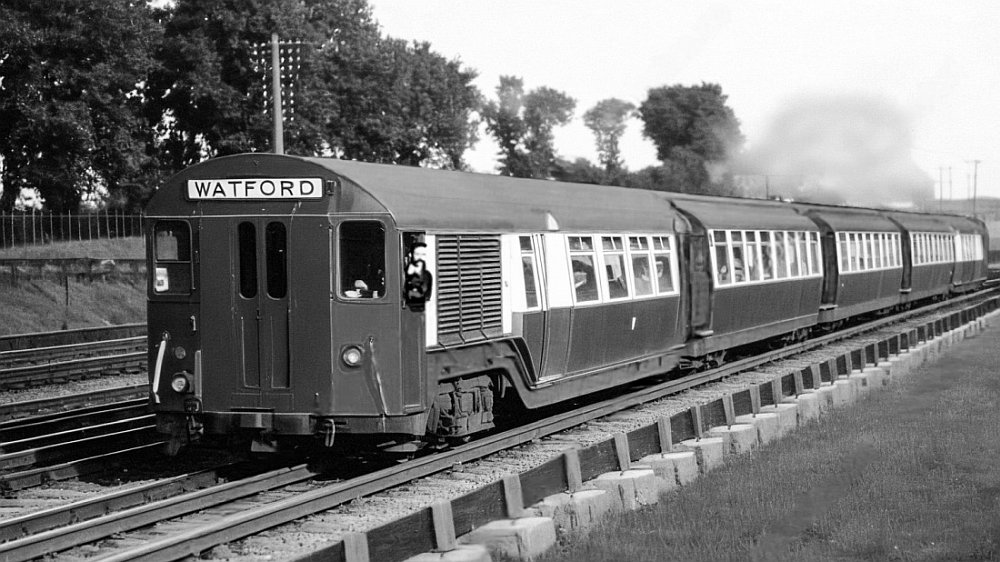
The most likely place one could possibly steal a Bakerloo train would be Watford. In any event a locomotive would need to be employed to whisk the train onward to new pastures somewhere in England, Wales or Scotland! A Watford bound train is seen at Kenton c1917 with Central London motor cars at either end. Image upscaled by the author (colourised initially but the black and white version looked better) from Railway World 1966. Original images at District Daves Forum.
The first fatality occurred soon enough…
It didn’t take long for the line to acquire its first fatality. The headlines screamed ‘Killed on the Bakerloo’ – as if had been some sort of resounding success. A death foretold maybe? Whatever, there’s no doubt deaths on the tube were rather frequent and the fact the Bakerloo managed a mere 17 days before its first traffic fatality showed there could never be a completely safe tube line in any way or form. Thankfully it hadn’t occurred on the first day – like the unfortunate William Huskisson M.P. who was killed at the opening of the Liverpool and Manchester Railway.
The Bakerloo’s first death was one of the company’s own employees. The victim had lived at Dennis Street in King’s Cross. (Evening News 27th March 1906). He had fallen into the path of a train and initially it had been assumed he had lost consciousness. The date this occurred was Tuesday 27th March 1906. However many early reports gave the name of the victim wrong – and he did not lose consciousness either.
For the next week or so many papers carried reports that focussed upon this unfortunate mishap and most indicated this was the first ever fatality on the line. Later reports however gave the correct name – John Creagh – a train conductor. For some reason he left his post and entered the tunnel at Kennington Road and was killed by a train. (Daily Express 31st March 1906).
The driver of the train informed the inquest Creagh was supposed to stay where the points switch lever was. These levers controlled the crossovers at the station so it is possible the train had come from the depot and was about to go into service and Creagh, the train’s conductor, was meant to switch the points and remain where he was. When the driver looked out of his cab to see how far he had reversed, he saw Creagh being crushed by the train. Creagh had entered the tunnel as the train was about to reverse and its not known why he did that. (Reports on the inquest from Daily News 31/03/1906, Halifax Daily Guardian 31/03/1906).
The Bakerloo becomes official…

The fancy font used for the Bakerloo tube’s early identity – examples of this can be seen in the picture below. Part of this is also used as the feature picture. Reproduction image created by the author.
By June 1906 signs were being put up referring to the line as the Bakerloo tube. Finally the company was getting round to using the new name! As one journal put it the new name had been ‘quasi-officially recognised’.

By 1907 every sign that indicated the Baker Street and Water… sorry, the Bakerloo, were completely widespread and it was probably the exterior of its station buildings that mainly had the line’s original name showing. Picture is of Great Central aka Marylebone. LT Museum.
The Bakerloo begins the tube’s first ‘OPO’ services…
The Bakerloo has the honour of being the first to try out any means of reducing the number of staff at stations, especially as it had two that were quiet. It certainly was a form of One Person Operation even though the trains continued to have their conductors and drivers. The idea was extraneous staff would be removed where possible – and a solitary member of staff placed in charge of the process of selling tickets, operating the lifts and the rest of it.
Trafalgar Square, a somewhat underused station at times surprisingly – a problem that continued to bedevil the Bakerloo at one or two of its stations, saw a novel experiment undertaken in view of the need to lessen staffing numbers. A passimeter – possibly one of the first ever employed on the tube – was located right by the lifts. The ticket clerk could therefore operate the lift as well as issue and collect tickets (Westminster Gazette 4th October 1922) and the endeavour was described as a ‘labour saving device.’ In a sense this proved somewhat ineffective for the next step was to place the passimeter inside the lift itself.
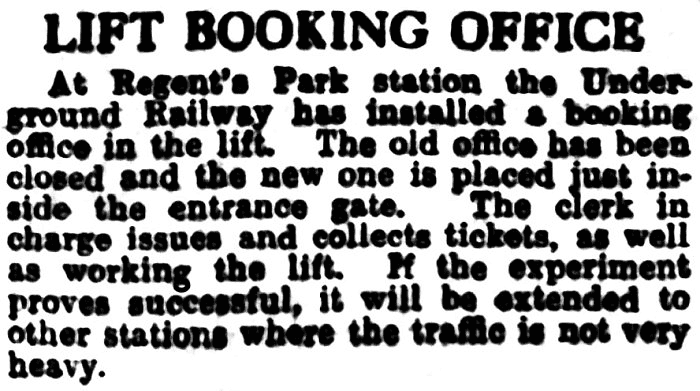
In the light of previous plans where the UERL had indicated Regent’s Park station ought to be closed as it had so few passengers using it. The line’s bosses had concluded there simply was no point in having a station so underused. Yet a number of people objected and in due course an alternative to closure was found. The station had its ticket office closed shut in the summer of 1924 and any ticket sales and checks were instead operated from a booth in one of the lifts. (Westminster Gazette 2nd June). This was no doubt the first of a number of lifts where staff doubled as ticket clerks as well as lift operators. There is every possibility one of the station’s three lifts was taken out at this time which would have been that adjacent to the emergency stairs.
The station was once again threatened with closure when its lifts came up for renewal in 1983. The GLC intervened and paid for the installation of new lifts. These days the station sees a fair number of passengers, but at times it can be exceedingly quiet. Its probably the area’s hospitals and colleges and universities and health clinics that help to keep the station’s numbers up.
The Bakerloo’s colourful stations – what remains today…
Let’s first recall the colours that were specified back in 1906.
Kennington Road (Lambeth North): Light green and dark green.
Waterloo: Green and dark brown.
Embankment: Green and light brown.
Trafalgar Square (Charing Cross): All white (down platform), light green and light brown (up platform).
Piccadilly: Green and celeste blue.
Oxford Circus: Dark brown and blue.
Regent’s Park: Light brown and amber.
Baker Street: Oxford blue.
And also the later stations:
Elephant and Castle: Ruby red.
Marylebone: Green and cream.
Edgware Road: Brown and cream.
If one examines the stations presently, this is 130 years later, it will be seen none of the stations actually sport the original colours. In fact the only remnants from those stations described above is Regent’s Park where the staircases reveal the original colours in their full glory. The platform areas have been retiled in a scheme somewhat similar to how the station once looked – though its not as characteristic or as vivid as the original tiles seen on the emergency staircase.

Its not on the Hidden London tour (as that takes a different route) however this section which is largely full of stuff stored can just be seen through some grilles on the northbound Bakerloo platform. Twitter/X.
Baker Street still does have Oxford blue tiling (and also a darker blue which must be celeste blue) but its in off-limits areas. There however is one area where one can peer through a gated entrance on the northbound platform and spot some of the station’s original blue tiles. However one will notice a difference. Those very tiles are much lighter than the Oxford Blue used today. The public areas of the Bakerloo station has a repro colour scheme – to be found in the corridors and stairways – but its modern and the colours are actually different. The Oxford Blue at Baker Street these days is a much darker shade – nevertheless that is probably the correct tint in terms of today’s paints.
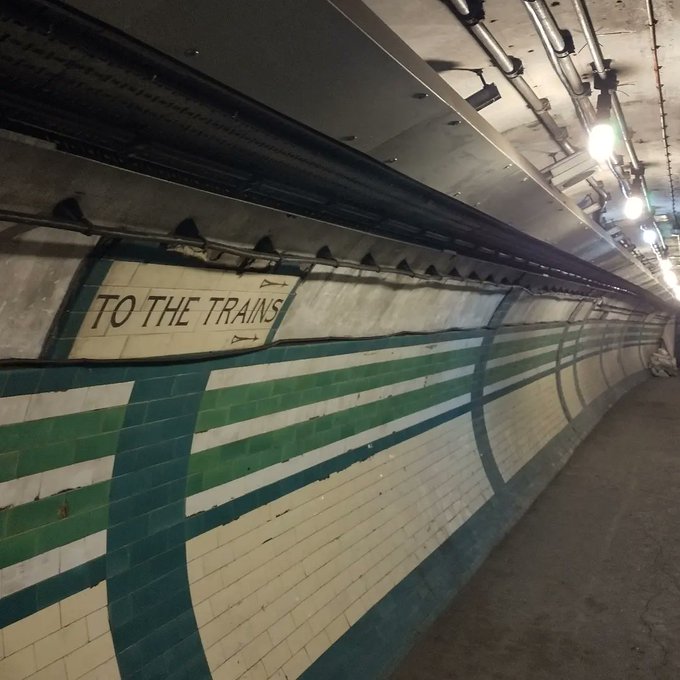
Green and celeste blue for the Bakerloo in the old tunnels at Piccadilly Circus. Twitter/X.
Other stations such as Oxford Circus, Piccadilly Circus and Waterloo have their original tiles too – but those can be seen only in the areas that are off-limits. Those at Baker Street, Piccadilly Circus or Trafalgar Square (Charing Cross) can however be seen by way of the station tours offered by the London Transport museum. Some parts of Marylebone has original tiling in the public areas.
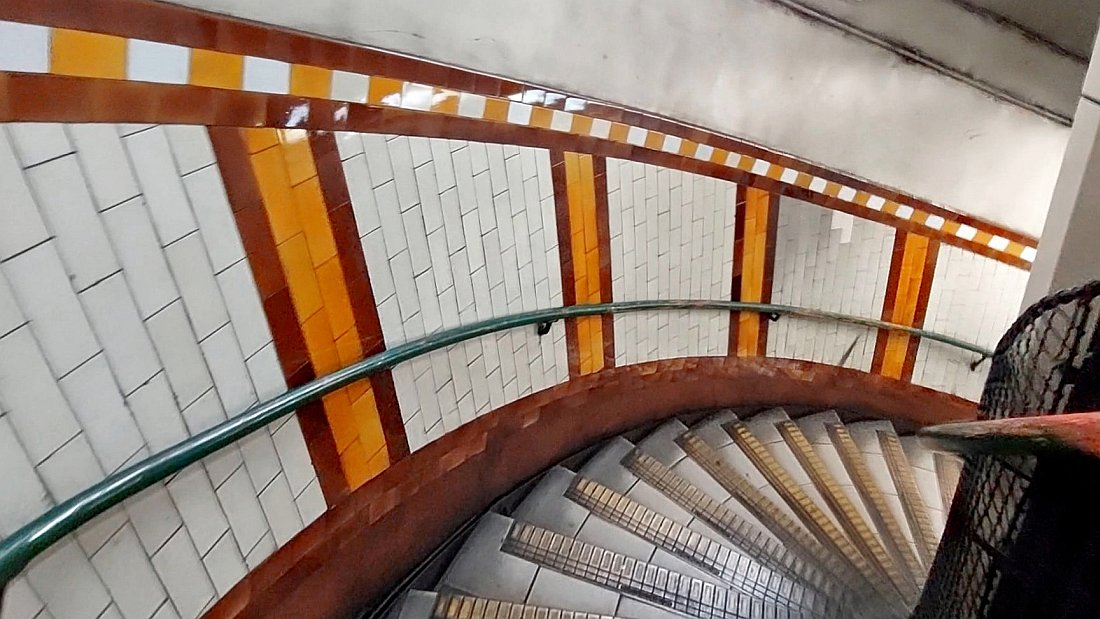
Regent’s Park stairs and the station’s original tiles are evident.
The original Embankment never had a spiral staircase to begin with, thus the reference must allude to the lengthy sloping corridor that once led from the Bakerloo to the District railway platforms. Its no longer part of the station’s public areas though it still exists. The station’s other celebrated corridor between the Bakerloo and Northern lines has original tiles that are green – and its a popular location for taking photographs – but there’s no brown tiles to be seen anywhere!
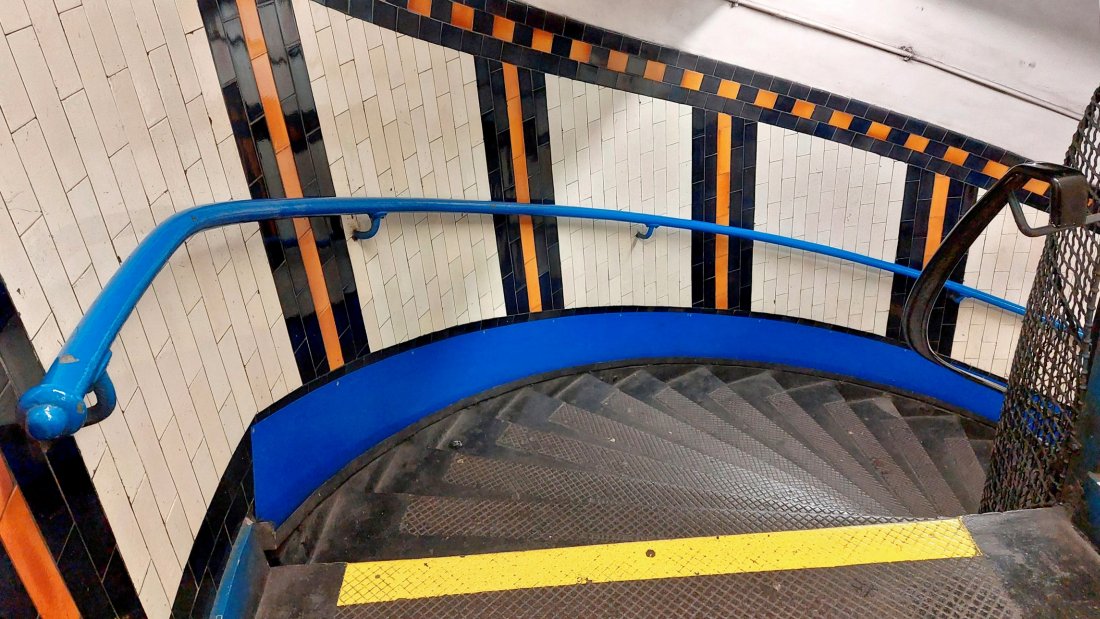
Lambeth North. The stairs are original however either the scheme colours were changed early or the newspaper was wrong.
Of the other original stations opened Kennington Road (later Westminster Bridge Road and Lambeth North) has a completely different scheme to that described (its gold and black). Either the 1906 description is wrong or the colours were changed at some point early in the station’s history. Elephant & Castle has none with tiles although a partial rendering of the original colours can be seen around the lift areas and passageways (its colour scheme was ruby red).
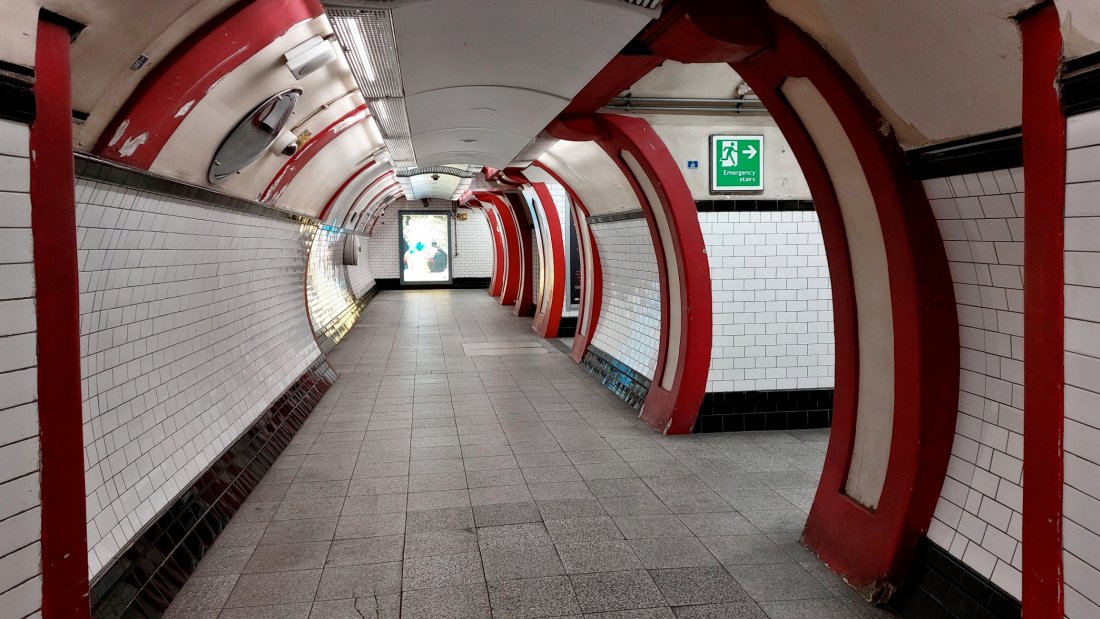
Elephant & Castle (Bakerloo) no longer has original tiling. However this modern colour scheme pays a small homage to the original by using ruby red for the pillars.
Apart from Regent’s Park, the only other stations with any original tiles to be seen in the public areas are Edgware Road and Marylebone. Both of these have been modernised considerably (Edgware Rod in the 1990s|) however despite Edgware Road’s complete re-tile job (save for the original Leslie Green ticket hall which is heritage), part of the stairwell still sports its original tiles. Marylebone still has elements of the original scheme in the non-public passageways that once linked up the former lifts and emergency staircase as well as some areas on the platforms.
Regent’s Park, Marylebone and Edgware Road are the only stations on the Bakerloo that still have tiled names. Of these three stations, the names for Regent’s Park are not original although the modern tiling does justice to what had been there before.
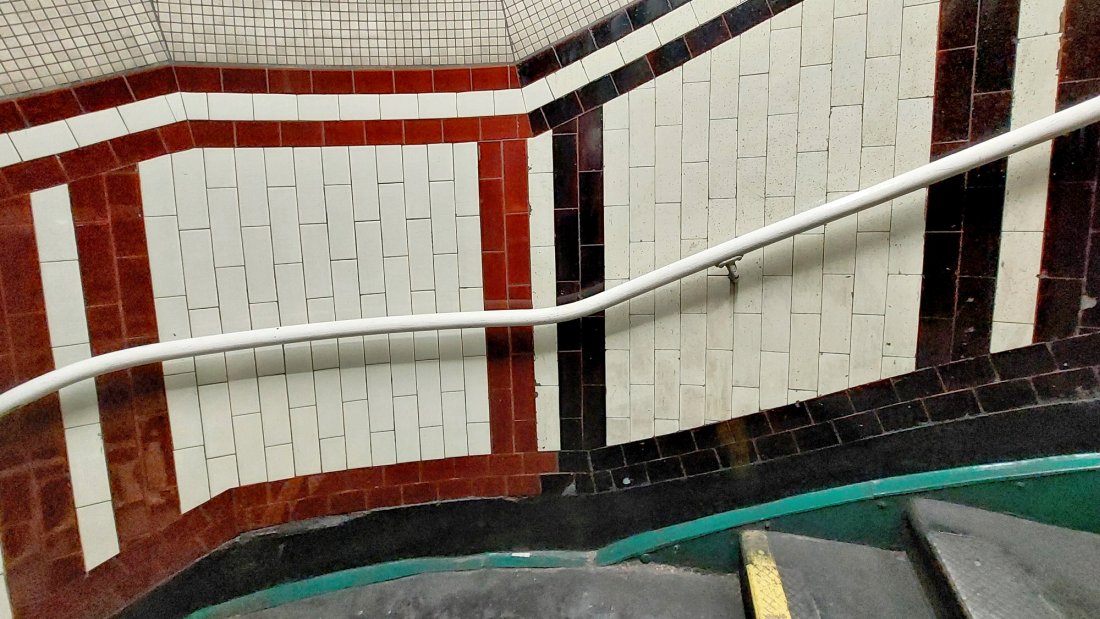
Edgware Road. The new and the original tiling meet on the emergency staircase.
The former Bakerloo terminus station (a role it performed from 15th June 1907 to 1st December 1913) does retain its original ‘Edgware Road’ tiled sign and this is one of just two stations (the other is Euston Road aka Warren Street) on the entire tube system that have the station name encased within a frame. In the days when the station was a terminus the large letters would have no doubt prompted passengers that was the end of the line and it was time to change to an omnibus or a tram from outside the station.

Edgware Road’s station name in tiles. A plaque says ‘This sign was part of the original tiling scheme of 1907’.
Marylebone has a mix of tiles, thus some areas are some rather newer tiles that reflect the original – these are from either the 1940s or the 1960s when major alterations were carried out to the tube station. Other tiling (such as that pictured below) are the much older (original) 1907 ones. If one goes right to the end where ‘Great Central’ is (the station’s former name) the tiles here are from 1907.
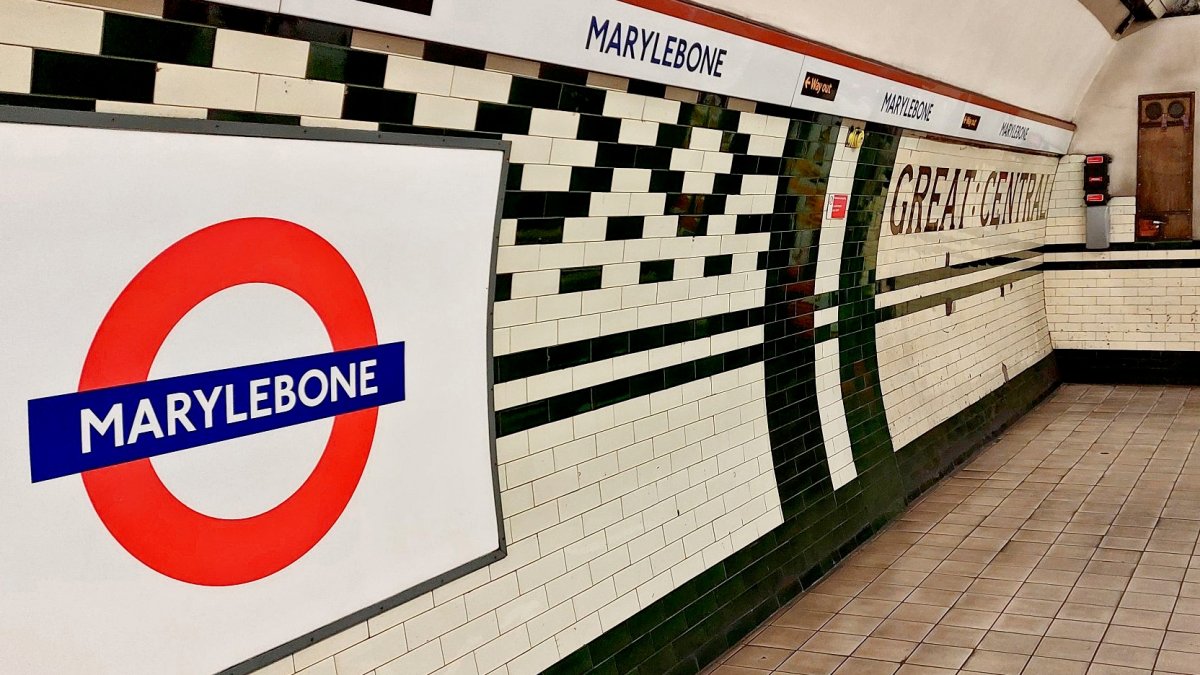
The one part of Marylebone tube station that’s original is the section with the ‘Great Central’ station name. Close inspection of the station name will reveal its letters to have been maroon previously – the ‘Great Central’ that can be seen today has been painted over with brown in line with the other stations that have tiled names. Many other parts of the station are old but not original.
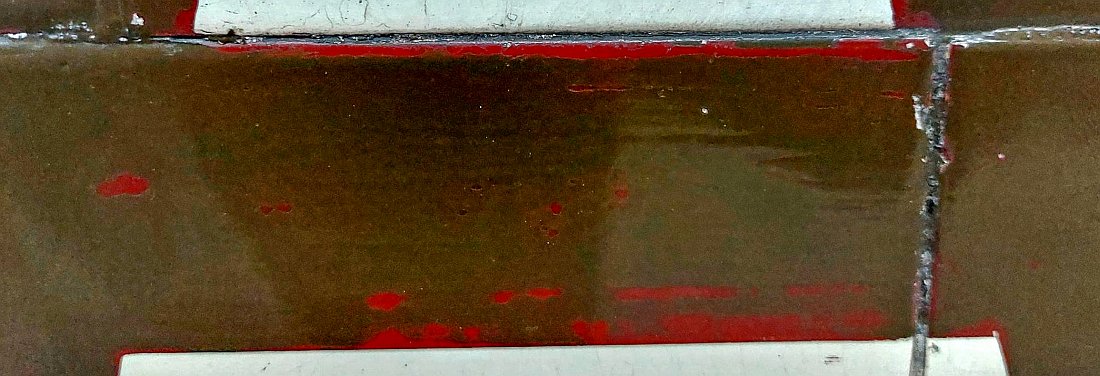
Any colour you like! Marylebone’s station name was originally maroon. At some later date it was painted brown!
The Bakerloo’s extensions…
Although the initial section of line to be opened was that between Baker Street and Kennington Road (later Westminster Bridge Road and ultimately Lambeth North), extensions to the line had been underway at the time of the line’s opening. That to the Elephant and Castle opened on 5th August 1906, whilst the section from Baker Street to Great Central opened on 27th March 1907 and then onward to Edgware Road 15th June 1907. Hence its those stations between the Elephant and Edgware Road that can be considered the extent of the line as it was originally intended.
After a period of indecision on where the next extensions should go, it was decided that Paddington should be next. How the line would approach Paddington was another matter. It was only after a suggestion that the Bakerloo linked with the LNWR at Queen’s Park that the company was able to orient a focus on the next stage of the line which would mean a route from Edgware Road down to Praed Street and then round into a new station deep beneath Paddington station itself. On 1st December 1913 Paddington became the terminus of the line, and this remained until 1915 when the Bakerloo was further extended to Queen’s Park. The first part was to Warwick Avenue and Kilburn which opened on 31st January 1915. Maida Vale station would open a few months later. Queen’s Park was reached on 11th February 1915. Eventually the line was extended again, initially to Willesden Junction, on 10th May 1915. Ultimately Harrow and Wealdstone and Watford Junction were reached with the first services operating from 16th April 1917.
There’s so much more to it than that but this seems a good enough summary of the line’s extensions in those early days. Certainly the extension to Stanmore (1939) and its subsequent transfer to the Jubilee line (1979) has been well written. The current proposals to extend the line to Lewisham is a big step forward and has seen considerable progress. In fact a new station is being built (well sort of) at the Elephant. This is a new ticket hall within the new development which will improve access. It will also accommodate the new extension should that be built. There’s every hope this will succeed where other earlier proposals to extend the line to Camberwell, Peckham and even Crystal Place have failed.
The main feature image is the end part of the Bakerloo tube’s original 1907 sign – in other words the linked letter ‘O’s and the word ‘TUBE’ underneath those. Image created by the author.

Leave a Reply